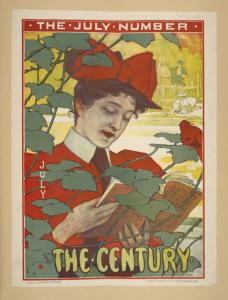
http://digitalgallery.nypl.org/nypldigital/explore/dgexplore.cfm?topic=printing&col_id=212
1. Selection Principles
The first page that a user views after opening the link to the gallery describes the history of the New York Public Library's collection of over 1200 posters from the end of the 19th century and beginning of the 20th. There are 1,000 of the 1,200 or so images available in the digital archive, and the intro text states that the Library's intention is to put all of the rest up as well. It does not say when, nor how or why the original 1,000 were chosen to be put up first. There is a paragraph on the background on turn of the century poster art as a genre that is helpful for someone unfamiliar with the period and form. It also helps justify in general the existence of the collection as a digital asset. As well, resources on the period and genre of the art represented are offered for users interested in further reading.
2. Metadata
In the introduction page offers metadata on the collection. It gives provenance information, stating that many of the posters were donated together by Anna Palmer Draper, who was a major donor supporter of the Library until she died in 1914. The paragraph states that the origins of the rest of the collection are unclear. As well, the introduction describes the physical condition of the actual prints, which Library staff mounted on cardstock and bound in volumes by name of the artist alphabetically, rather than retaining original order of the Draper donation. As I mentioned above, there is also background information on the genre generally available on this page, and resources for further reading. The collection offers a lot of useful metadata for individual objects, and uses some of its metadata (such as subject tags presumably added by Library staff, not general users) for search functions within the collection. Some pieces of the data, like the subject tags, appear on the left of the page with boxes a user can check and hit a "go" button to find similar objects. Beneath each image, there is an "Image Details" link that can be clicked to expand and show the image title, image creator and any other names associated with the image, creation date, source, location where poster is physically housed and its call number, a digital ID number, a record ID number (thought it doesn't explain what these numbers mean or where they came from), and when the digital item was published as well as when it has been updated, which I thought was a useful addition that I didn't see on the last collection I reviewed.
3. Objects
The images are clear and can be searched according to key words in a text-box format or through checking boxes next to the provided subject tags and hitting "go" to retrieve other images with similar tags. The collection can be viewed in its entirety in thumbnails arranged alphabetically by title. When selecting to view one image specifically, only two size formats (smaller and larger) are supported, without good zoom capability. This function is found above the image on a "resize" button that when hit blows the image up. There are also buttons above the image for "print, "buy," "select" to add to a list a user can make of images useful to them, and "resize." One helpful thing that the collection offers is a permalink and a string of HTML for embedding the image on a web page.
4. Audience
There is no direct statement about the intended audience of the collection. It is easy enough to navigate that it may serve even a k-12 educational kind of purpose, but I believe scholars and interested folks would find it useful, too. Really in depth kinds of art history scholarship would not be facilitated by the gallery because of the inability to really zoom in on the image, as compared to, say, the Prado images we looked at in class from Google Earth.
No comments:
Post a Comment